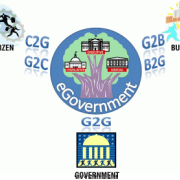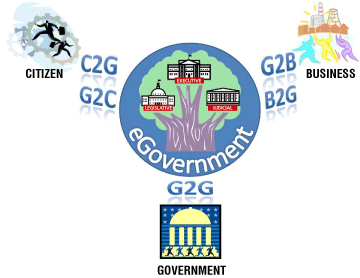
Evolutionary E-GovernmentIn the coming decade, governments will continue to realize incremental, technology-enabled improvements through the application of proven or emerging IT process improvement principles. Government 2.0 will continue to hold sway. | Transformative E-GovernmentIn the coming decade, we will see a game-changing paradigm shift in which technology-driven government will rule, resulting in the radical reinvention of governmental processes set in stone for over the last 200 years. Herald the arrival of Government 3.0! |
"More than any other sector, governments around the world stand to benefit the most from the effective application of information technology."
-- Mitchell Ummel, Guest Editor

Opening Statement
Government is often perceived -- by its most overt critics or ambivalent constituents -- as unnecessarily bureaucratic, fraught with inefficiency, and less than agile in its ability to react and respond to the needs of its citizens and the industries it serves. To some, government seems to overpromise and underdeliver. The reasons for this are many and not just related to the specific challenges inherent in implementing information technology, but in the implementation of change itself.
Yet there is hope of technology-inspired change on the near-term horizon. Governments at all levels are in the midst of an extraordinary transformation. One catalyst for this transformation is a newly "e"-nabled, Internet-savvy citizenry -- a citizenry that expects (and prefers) electronic interaction with their government and real-time responses, anytime, anywhere, anyhow. Another catalyst is renewed mandates for government accountability, transparency, and accessibility, the likes of which civilization has never seen before. Some refer to this general movement as "e-government," with additional labels of "digital government," "open government," "Government 2.0," and/or "e-democracy" sometimes used in certain contexts.
It's generally accepted that e-government consists of a number of perspectives, depending on the subject of the external interactions (see Figure 1). The multiple perspectives of e-government are typically characterized as shown in Table 1. Although this outside-in view of e-government "at the edges" is common, an even more interesting proposition involves an "inside-out" view. Specifically, what is the optimal set of people, processes, and technology required to carry out essential government services, and are these governmental processes, now technology-enabled, radically different from those that have been realized before?
Table 1 -- Characteristics of the Multiple E-Government Perspectives
| E-Government Perspective | Characteristics |
| Government « Citizen | Increased government transparency, accountability, freedom of information, e-democracy, digital electronic voting, constituent services, electronic legislative and judicial processes, accessibility anytime, anywhere, anyhow |
| Government « Business | Public/private partnerships, increased collaboration between government and private sector, increased government support for business development |
| Government « Government | Increased levels of interagency collaboration and cooperation, citizen opt-in for information sharing, intelligence, and unified case management |
Government is by far the largest institution on earth, dwarfing even the most massive of global private sector companies. Consider the analogy of government as an industry. Citizens are somewhat like involuntary public shareholders in their governments, and whatever voice each of us has seems to be drowned out by the inefficiencies of the political "stock market" processes, the elected politicians serving careers on the government "board of directors," and the din of millions of other citizen "shareholders."
More than any other sector, governments around the world -- and this includes governments at the federal, territory, provincial, state, county, city, village, etc., level -- stand to benefit the most from the effective application of information technology. Achieving this would effectively drive us into a new era of "transformative e-government" -- or what I refer to as Government 3.0 -- something that can be realized in the current decade (2010-2020).
Where Government 2.0 has been guardedly evolutionary, we will find Government 3.0 to be radically transformative.
Transformative government is less about the technology than it is about freeing our thinking to embrace change itself. It's all about breaking free of the shackles of fiscal year budget planning cycles and thinking more broadly about planning, perhaps a decade forward in horizon, across the politics of multiyear election terms. It takes a long time to accomplish big things. How many tech-savvy children of the 1980s and 1990s will need to be elected in order for this digital culture shift to reach a tipping point? Must we first stop doing things in ways we've always done them before we have the time (or resources) to think about, and imagine, new ways of defining government?
IN THIS ISSUE
In this month's Cutter IT Journal, we have selected five articles that provide a wide variety of insight into the character of the e-government space, both today and into the future.
Differentiating Government IT
Macedonio Alanis begins the issue by speaking to the power of governments to benefit their people and regions, underscoring this sector's importance to society in the coming decade. He argues that "dealing with the government must be just as easy as -- or even easier than -- dealing with your bank, your convenience store, or your supermarket." He explores how the rhythms of politics (election cycles, budgets) influence the timing and priorities of e-government projects and offers lessons for each of e-government's three constituencies -- employees, IT suppliers, and the general public -- on the development, supplying, and consumption (respectively) of e-government solutions. In one example, he describes a transformative government project for which success was not measured in dollars, but in the value of time and efficiency for the citizens it was designed to serve. Springboarding from his work contributing to Mexico's national IT policies, Alanis effectively differentiates public sector IT from private sector IT and delves into the most critical differences that we -- whether as government employees, private sector suppliers, or citizens -- must be aware of and embrace.
E-Government and Agility
Next, Steven Baker shows how embracing agile practices within the various dimensions of outward-facing e-government (C2G, G2B, etc.) can help cash-strapped municipalities continue to provide services -- and find new ways to serve -- in these tough economic times. Baker, who serves as a council member for the city of Berkley, Michigan, USA, offers examples from real-world municipal government to show how agile-inspired methods can be effectively applied to domains beyond IT. He also explores the inward-facing domain of government operations and summarizes by suggesting new ways of thinking about agility, prescribing four generalized key principles for adopting a more agile approach to e-government.
Doing More Without More
Our next author, David Wyld, effectively demonstrates how critical the "process of process improvement" is to the outmoded government procurement processes of the past 20 years. Wyld examines how US Customs and Border Protection (CBP) has worked in partnership with FedBid, Inc., a private sector firm in Vienna, Virginia, USA, that operates the FedBid online reverse auction marketplace. Specifically, the article describes how CBP "utilized FedBid's online marketplace to revamp its procurement processes, saving tens of millions of taxpayer dollars in its purchasing operations while significantly improving operational efficiencies." Wyld details the savings CBP has achieved by opening more of its buys to competition, particularly for items that were previously sole-sourced. He further notes that CBP's use of the FedBid online marketplace has enabled its procurement professionals to spend more time on outreach and support efforts for their internal customers and allowed them to engage in higher-level tasks.
E-Government and Transparency in Emerging Countries
In our next article, Doug Hadden discusses how the digital divide between developed countries and developing countries is beginning to close. He looks at emerging countries and explores what he refers to as the "push" factors and "pull" factors that are driving e-government initiatives in these countries. He also discusses "leap" factors, such as how mobile-enabled developing countries are using their so-called latecomer advantage to leapfrog more developed nations in adoption of e-government services, focusing particularly on government transparency and freedom of information.
A CIO Perspective on E-Government
We conclude with an article by Pablo Lera, Mabel Ciancio, and Jorge Ronchese, who describe the real-world, day-to-day experiences -- and lessons learned -- of the CIO of a city government agency during his first three years on the job. In one of the authors' most profound statements, they suggest that an agile government results when positive feedback loops develop between citizens' perceptions of response and their government's actions -- and that these feedback loops are effectively setting priorities for budgets and agendas within government organizations. The challenges and opportunities expressed in this case study may well echo the collective experience of many government CIOs who are becoming e-government-driven.
CONCLUSION
Government as an institution has a long road ahead in regaining the trust and admiration of its constituents. The articles presented in this month's Cutter IT Journal only scratch the surface of all that is right with government sector IT, and we hope they will shine the light for others who are working toward the effective application of technology and change in the government space.
Some suggest that e-government in general, applied in an evolutionary manner (as is currently the case), is the answer. I argue that the principles of transformative e-government, or Government 3.0, will be critically important in the decade ahead. In the Government 3.0 era, we will focus less on the enabling technologies and more on the people (organizational) change and process change that need to be implemented to effect large-scale, long-term governmental efficiency and effectiveness.
ABOUT THE AUTHOR
The November 2010 issue of Cutter IT Journal is a call-out to innovators in government and/or the private sector who are embracing the idea of e-Government, and realizing the promise of a new level of digital government maturity.








